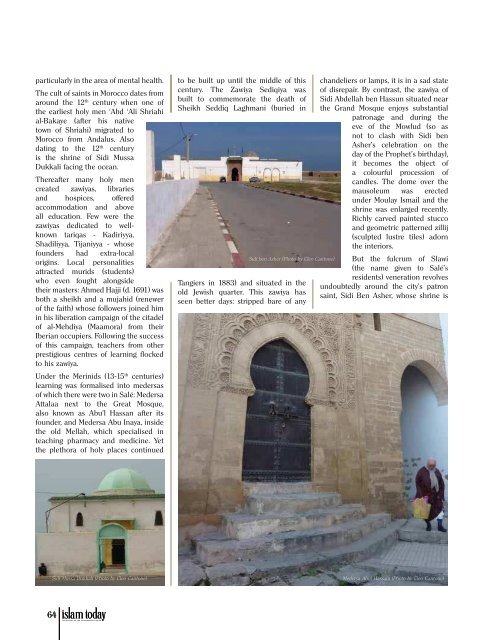You also want an ePaper? Increase the reach of your titles
YUMPU automatically turns print PDFs into web optimized ePapers that Google loves.
particularly in the area of mental health.The cult of saints in Morocco dates fromaround the 12 th century when one ofthe earliest holy men ‘Abd ‘Ali Shriahial-Bakaye (after his nativetown of Shriahi) migrated toMorocco from Andalus. Alsodating to the 12 th centuryis the shrine of Sidi MussaDukkali facing the ocean.Thereafter many holy mencreated zawiyas, librariesand hospices, offeredaccommodation and aboveall education. Few were thezawiyas dedicated to wellknowntariqas - Kadiriyya,Shadiliyya, Tijaniyya - whosefounders had extra-localorigins. Local personalitiesattracted murids (students)who even fought alongsidetheir masters: Ahmed Hajji (d. 1691) wasboth a sheikh and a mujahid (renewerof the faith) whose followers joined himin his liberation campaign of the citadelof al-Mehdiya (Maamora) from theirIberian occupiers. Following the successof this campaign, teachers from otherprestigious centres of learning flockedto his zawiya.Under the Merinids (13-15 th centuries)learning was formalised into medersasof which there were two in Salé: MedersaAttalaa next to the Great Mosque,also known as Abu’l Hassan after itsfounder, and Medersa Abu Inaya, insidethe old Mellah, which specialised inteaching pharmacy and medicine. Yetthe plethora of holy places continuedto be built up until the middle of thiscentury. The Zawiya Sediqiya wasbuilt to commemorate the death ofSheikh Seddiq Laghmani (buried inTangiers in 1883) and situated in theold Jewish quarter. This zawiya hasseen better days: stripped bare of anychandeliers or lamps, it is in a sad stateof disrepair. By contrast, the zawiya ofSidi Abdellah ben Hassun situated nearthe Grand Mosque enjoys substantialpatronage and during theeve of the Mowlud (so asnot to clash with Sidi benAsher’s celebration on theday of the Prophet’s birthday),it becomes the object ofa colourful procession ofcandles. The dome over themausoleum was erectedunder Moulay Ismail and theshrine was enlarged recently.Richly carved painted stuccoand geometric patterned zillij(sculpted lustre tiles) adornthe interiors.But the fulcrum of Slawi(the name given to Salé’sresidents) veneration revolvesundoubtedly around the city’s patronsaint, Sidi Ben Asher, whose shrine islocated in the cemetery that bears hisname and is surrounded on three sidesby the walls of Borj Addumun. Initiallyburied under a fig tree, Abdullah ibnIsmail then erected a domed chamberand others have continued to renovateand expand the shrine ever since.Regardless of the number of shrinesstill standing, it is the number ofzuwwar (shrine visitors) to the smallerzawiyas in particular that has declineddramatically. Were it not for the candleprocession of the two main saints, thereis little doubt that a further declinein maintenance and attendance willfollow. Ironically, the origins of theseprocessions derive from ChristianSpain: they were initiated by the Emirsand ulema of Sebta in the 13 th centuryas a response to Christmas celebrations.The use of candles started in the 16 thcentury but was actually Ottoman ininspiration. The candles are arrangedto imitate lanterns and suspendedfrom the domed chamber of the saints’tombs until the day of the procession.If candles ensure the success ofthe procession’s spectacle, it is thewomen who patiently thread theminto vibrant patterns who hold the keyto keeping alive the cult of saints. Itis this intersection between faith andfolklore, devotion and worship andbetween Sufism and orthodox Sunnismthat enriches Islam in Morocco, thusfar seemingly impervious to extremistinfluences the likes of which havecaused the destruction of numerousplaces of worship and Sufi shrinesthroughout the Muslim world. Despitethe dwindling numbers of devotees, thepopular lore of Salé’s patron saints liveson. •Dr Cleo Cantone holds aPhD from the University ofLondon. Her book “Makingand Remaking Mosquesin Senegal”, based on herdoctoral research, hasrecently been publishedby Brill.6465


